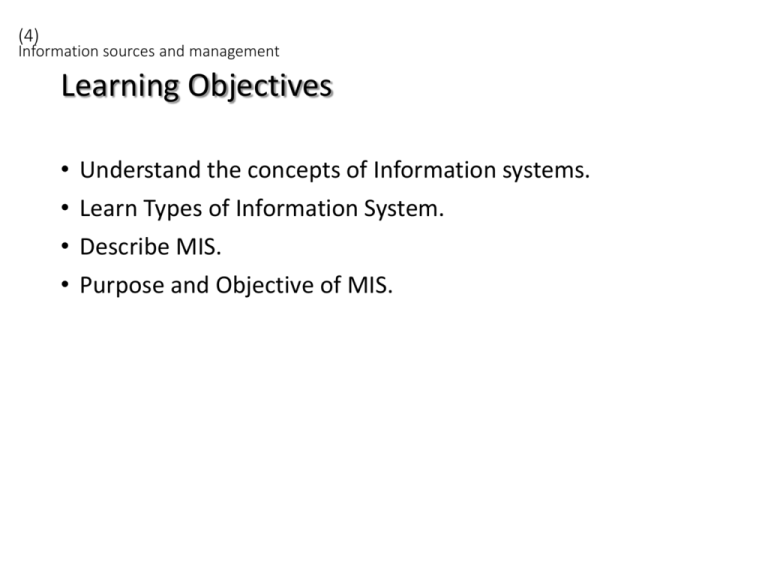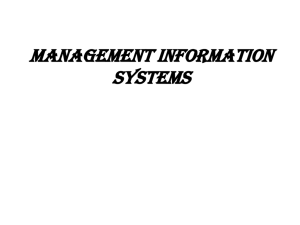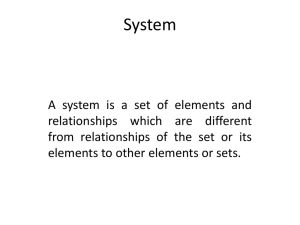Learning Objectives
advertisement

(4) Information sources and management Learning Objectives • • • • Understand the concepts of Information systems. Learn Types of Information System. Describe MIS. Purpose and Objective of MIS. (4) Information sources and management Information System An Information system is a set of people, procedures, and resources that collects, transforms, and disseminates information in an organization. An information system (IS) is typically considered to be a set of interrelated elements or components that collect (input), manipulate (processes), and disseminate (output) data and information and provide a feedback mechanism to meet an objective. (4) Information sources and management Continued… For example: Today’s end users rely on many types of Information Systems (IS). Some are simple manual information systems, where people use tools such as pencils and paper, or machines such as calculators and typewriters. A computer based information system uses the resources of people (end users and IS specialists), hardware (machines and media), and software (programs and procedures), to perform input, processing, output, storage, and control activities that convert data resources into information products (4) Information sources and management Components of I S Fig. 13.1: The Components of an Information System (4) Information sources and management Different Resources of Information Systems computer based information system consists of four major resources: • • • • People Hardware Software and Data. (4) Information sources and management Continued… People Resources: Specialists – systems analysts, programmers, and computer operators. End users – anyone else who uses information systems. Hardware Resources: Machines – computers, video monitors, magnetic disk drives, printers, and optical scanners. Software Resources: Programs – operating system programs, spreadsheet programs, word processing programs, and payroll programs. Procedures – data entry procedures, error correction procedures, and paycheck distribution procedures. Data Resources: Product descriptions, customer records, employee files, and inventory databases. Information Products: Management reports and business documents using text and graphics displays, audio responses, and paper forms. (4) Information sources and management I S Vs I T (4) Information sources and management Types of Information System Information Systems Operations Support System Transaction processing systems Process control systems Office automation systems Management Support System Management information systems Decision support systems Executive information systems (4) Information sources and management Transaction Processing System A transaction processing system (TPS) collects, stores, modifies and retrieves the transactions of an organization. Examples of such systems are automatic telling machines (ATMs), electronic funds transfer at point of sale (EFTPOS – also referred to as POS). There are two types of transaction of processing: • Batch processing: where all of the transactions are collected and processed as one group or batch at a later stage. • Real-time processing: where the transaction is processed immediately (4) Information sources and management Continued… Transaction Processing System Sales and Marketing Manufacturing & Production Finance & Accounting Human Resource System Order Processing. Statistical Analysis Accounting Wage System Advertising Ordering Raw Material Budgeting Attendance General Ledger Application Sales (4) Information sources and management Process Control System Process control systems monitor and control industrial processes. (4) Information sources and management Office Automation Systems The term office automation refers to all tools and methods that are applied to office activities which make it possible to process written, visual, and sound data in a computer-aided manner. An office automation system (OAS) facilitates everyday information processing tasks in offices and business organizations. These systems include a wide range of tools such as spreadsheets, word processors, and presentation packages. Office Automation Systems are software packages such as MS Office which include word processors, spreadsheets, databases, presentation software, email, internet, desktop publishing programs and project management software. (4) Information sources and management Continued… A Continuum (scale) of Human Control and Automation Fig: Human Control and Automation (4) Information sources and management Management Information System (MIS) The MIS is defined as an integrated system of man and machine for providing the information to support the operations, the management, and the decision-making function in the organization. Management Information System (M.I.S.) is basically concerned with processing data into information, which is then communicated to the various Departments in an organization for appropriate decision-making. (4) Information sources and management Features of MIS An MIS must have the following features: It must be capable of handling voluminous data. The data as well as transactions must be validated. It must be able to perform operations on the data irrespective of the complexity of the operations. Often time multi-dimensional analysis is required. An MIS should facilitate quick search and retrieval of information. An MIS must support mass storage of data and information. The information must be communicated to the recipient in time. Moreover, the communicated information must be relevant. (4) Information sources and management Decision Support System A DSS can be defined as a computer based information system that aids a decision maker in taking decisions for semi-structured problems. A DSS is an interactive, flexible and adaptable computer based information system that utilizes decision rules, models and model base coupled with comprehensive database and the decision maker’s own insights, leading to specific, implementable decisions in solving problems. (4) Information sources and management Executive Information System (EIS) An EIS, executive Information System is a form of MIS designed for upper management and provides information which might help them make decisions on a strategic level about future directions or issues concerning managers. An executive information system (EIS) is a highly interactive system that provides managers and executives’ flexible access to information for monitoring operating results and general business conditions. These systems are sometimes called executive support systems (ESS). EIS attempts to take over where the traditional MIS approach falls short. EISs provide executives with internal and competitive information through userfriendly interfaces that can be used by someone with little computer-related knowledge. EISs are designed to help executives find the information they need whenever they need it and in whatever form is most useful.






